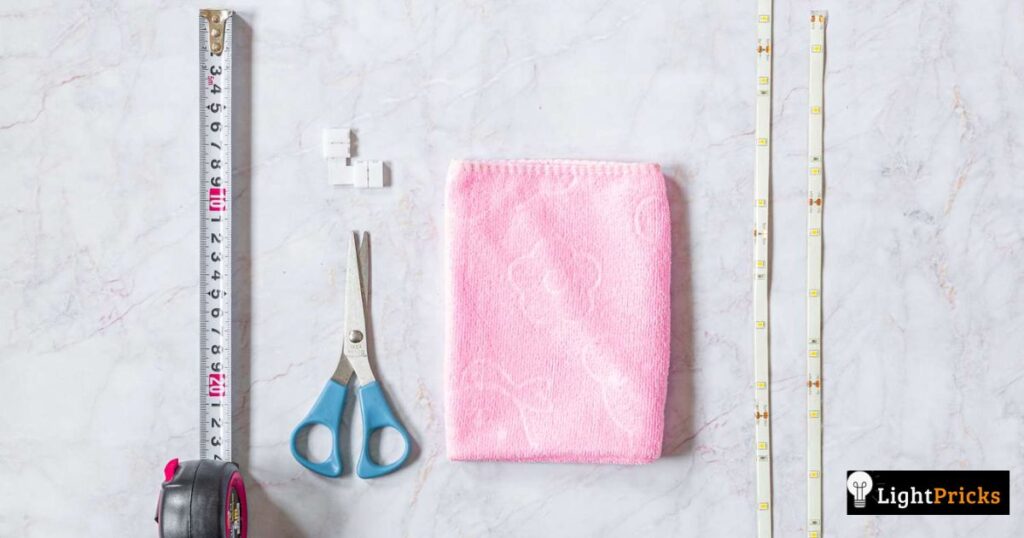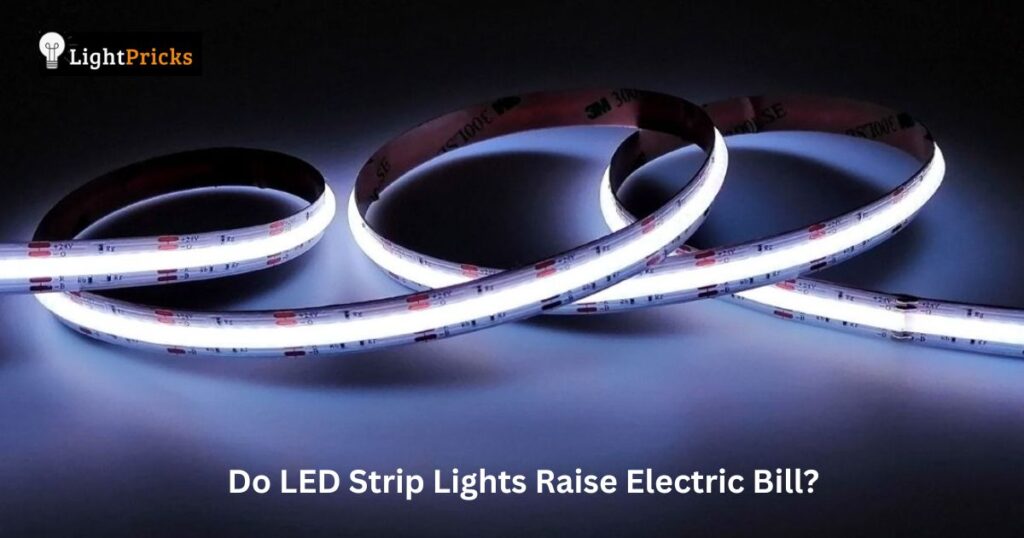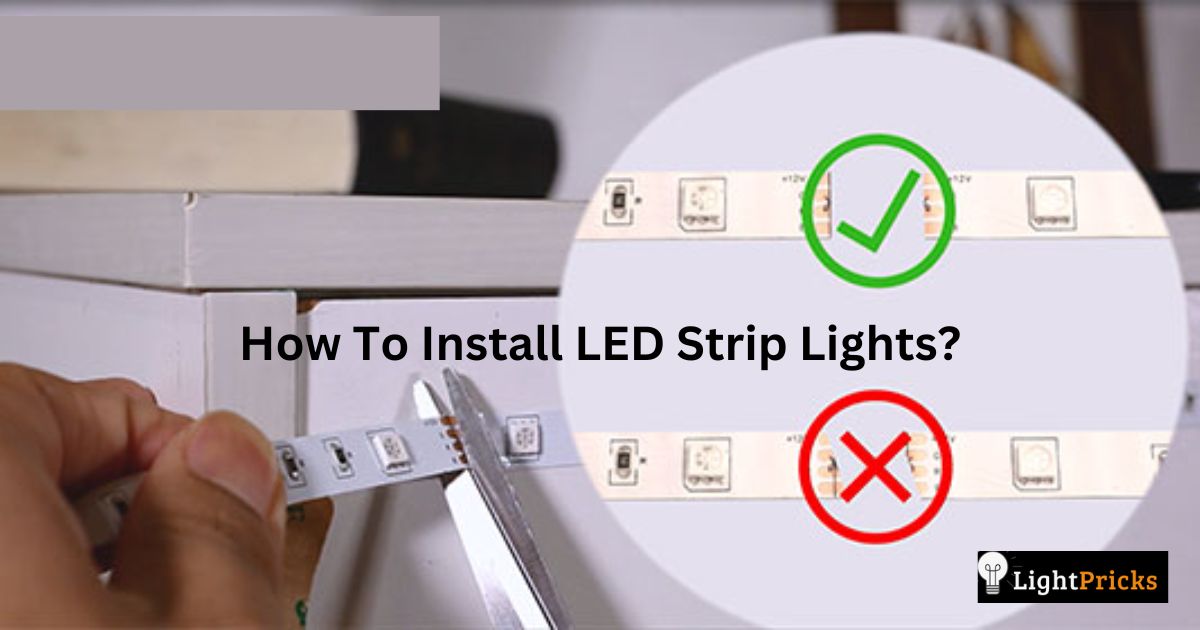LED strip lights are flexible plastic strips with thin panels of light emitting diodes that provide colorful illumination. They can be used to decorate homes, add bias lighting, or install behind cabinets and furniture.
Would you like to add fun lights to your room without much work? LED strip lights are simple to install and let you choose from many bright colors. Follow these clear instructions to safely put up your own colorful lighting with basic tools found around the home.
LED strip lights are a popular way to add decorative or functional lighting without a lot of effort. They come in handy rolls that neatly stick to surfaces. By carefully reading the guide, you will be able to install LED strips without trouble. This article will explain the easy steps to install LED strip lights and provide guidance on required tools and parts. Let’s start with gathering the needed materials.
Material Required For Installing LED Strip Lights

- LED strip lights: Choose warm white, cool white or RGB color changing strips depending on your preference. Make sure the voltage matches your home’s power.
- Low voltage transformer: Required to power 12V LED strips safely from a wall outlet. Must supply enough power for the strip length.
- Connectors: To link multiple strips securely together in long runs. Look for waterproof joints.
- Adhesive tape: For mounting strips to surfaces. Use insulation tape for insulation on low voltage wiring.
- Tools: Scissors, wire cutters, screwdriver. Optional: crimping tool for connectors.
Steps To Install LED Strip Lights
Here are the simple step-by-step guide for installing the lights:
1. Planning
Before starting, plan how you want the lights to look and where to position them. Measure the areas and note power outlet locations. Cut strips to required lengths with scissors or wire cutters. Leave slack for connectors. Mark connector positions along strips with tape for precision cuts.
2. Wiring
Run low voltage wires from transformer to first strip section. Connect white wire to strip plus and red wire to strip minus. Use connectors to join strips end to end. Stagger connections to avoid bunching. Insulate joints and wire runs with tape to prevent shorts.
3. Mounting
Peel backing from adhesive and carefully mount first strip section. Smooth out air bubbles. Repeat mounting succeeding sections snugly against first. For hidden runs, stick strips underneath shelves, behindTV etc. Use blackout tape to cover wiring joints and connector gaps if visible.
4. Powering Up
Plug transformer into outlet and switch it on. Test all strip sections light up as planned. Tidy away excess wire neatly out of reach. congratulations, your LED strips are ready for decoration and festive lighting. Enjoy your bright new room lighting for many years to come!
5. Programming (for RGB strips)
RGB strips let you change colors or operate in patterns. Download compatible app from manufacturer site. Connect controller to power source and control the strip wirelessly via Bluetooth or WiFi from your phone or tablet. Explore preset and custom color options for fun.
Tips For Maintenance And Use
- Avoid exposed wiring and mount strips safely away from curtains etc to prevent heating and fire risks
- For bathroom install, use only low voltage transformer mounted outside wet areas
- Clean LED strip surfaces gently with dry cloth only
- Replace broken connectors or strips promptly to prevent shorts
- LEDs may flicker at very low voltages, ensure sufficient power from transformer
- Store extras carefully in original packaging for future use
I hope these clear steps helped you install your own LED lighting with basic tools. Let me know if any part of the process needs more explanation. With practice, you will become expert at lighting up your space.
Do LED Strip Lights Raise Electric Bill?

Many people wonder if LED strip lights will cost more on their electric bill. But LED strips can actually save you money. LEDs use very little power compared to other bulbs. As long as you get the right kind of LED strips, you could save up to a quarter of what you usually pay each month.
That’s because LEDs give off the same bright light while using much less electricity. Be sure to keep cords tidy so no power goes to waste. Using LED strips is better for your budget and the environment too.
Installing LED Strips On Flat Surfaces
It is easy to stick LED strips on ceilings, walls, windows and the back of your TV. These surfaces are flat so the strip tapes stay firmly. First plan where you want the lights. Cut the strip to fit each spot. Peel back the tape strips a little at a time and smooth out the lights. Plug the transformer into an outlet near each spot. Turn it on to check everything lights up okay. Enjoy your new bright and colorful lighting.
Installing LEDs Around Objects And In Small Spaces

Putting lights on shelves, around corners or in cars needs more care. The surfaces curve or the space is tiny. For shelves, gently bend the strip to follow the edge before taping down. Use connector pieces where you need to join strip ends. In cars, run wires carefully not to get hot or blocked. Mount the power supply safely, like under a seat. Take your time to hide wires and joints. Your curved and hidden lights will look awesome.
FAQ’s
Do LED strips drain electricity?
Normal light bulbs use 60 watts every hour. If left on for 10 hours it uses 600 watts. But LED strips only need 9-12 watts per hour even if very bright. So LEDs cost less to run for a long time than other bulbs. This saves money on the electricity bill.
Are LED strip lights easy to install?
LED strip lights are easy to set up. You can plug them into walls or use remote controls. They make dark rooms brighter and highlight stairs and other areas. LEDs cost less to use than regular bulbs. Get the pieces to light up your home with colorful strips that shine brightly.
Do LED lights attract spiders?
Spiders won’t come to LED lights by themselves. But other small bugs might fly around the lights. Then spiders wait there to catch the other bugs for food. If you want less bugs and spiders, use lights that are more yellow or orange instead of blueish lights. Warmer lights don’t call to bugs as much. This can keep more crawlies away from your home.
Is it OK to sleep with LED strip lights on?
It is not good to sleep with bright LED lights on. The blue light can stop the body from making sleepy chemicals. Softer warm white or yellow strips are better. Or just use lights in other rooms and not the bedroom for sleeping.
Final Thoughts
How To Install LED Strip Lights? I hope you learned how easy it is to put up your own LED strip lights. Just follow the steps and take your time. Be careful when handling tools and electricity. LED lights will make your home look bright and colorful. You can plan different designs for festive occasions too.
Remember LEDs save money compared to other bulbs. Always switch them off when not in use. With practice, decorating with lighting will become fun. Let me know if you have any other questions. You can also ask a parent or teacher to help if needed. Once installed, enjoy your pretty new room lights for many nights to come.













